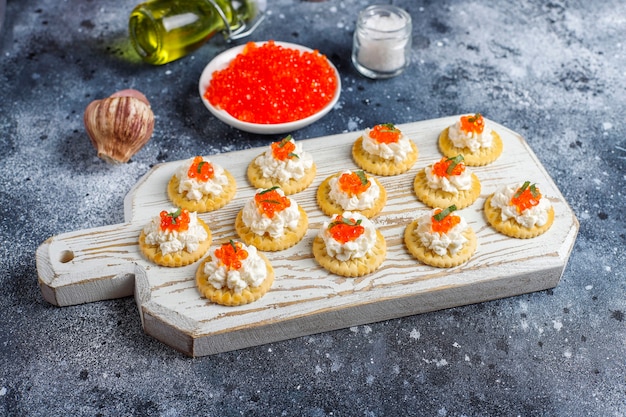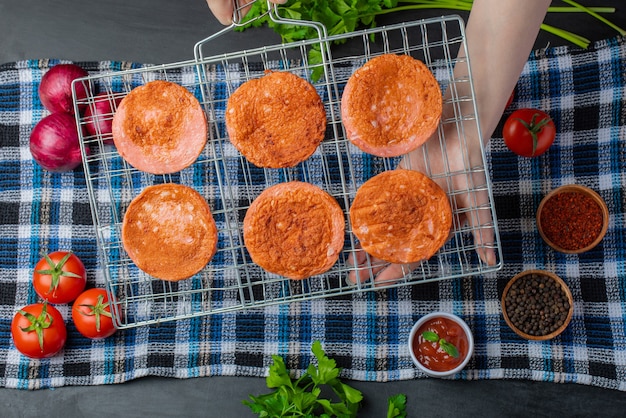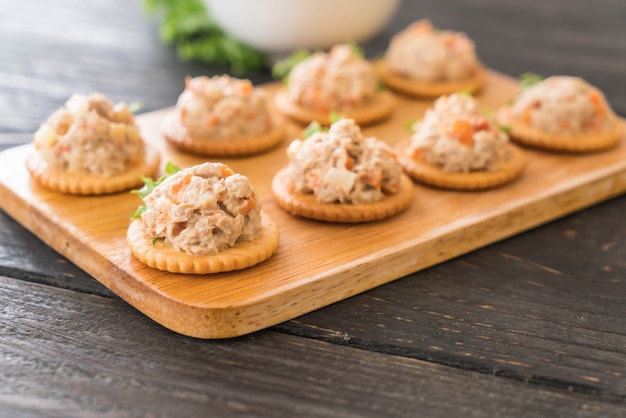Let's be honest, there's something undeniably satisfying about a perfectly crafted crab cake. That delicate, sweet crab meat, bound together with just the right amount of richness and a crispy, golden crust... pure bliss! But getting those delectable little morsels just right can seem a bit daunting. Fear not, my fellow crab cake enthusiast, because I'm here to guide you through every step, from choosing the perfect crab to mastering the art of the golden crust.
I've been making crab cakes for years, experimenting with countless recipes and discovering what truly makes a crab cake sing. So, put on your apron, gather your ingredients, and let's embark on this culinary adventure together!
(Part 1) The Foundation: choosing the right crab

You can't have a great crab cake without exceptional crab meat. But with so many options at the seafood counter, it's easy to feel overwhelmed.
The Crab Meat Showdown: Lump vs. Backfin
Think of it like choosing the right cut of meat. Lump crab is the steak of the seafood world – big, juicy, and undeniably luxurious. You get those beautiful, large chunks of meat, perfect for making a truly decadent crab cake. But it comes with a higher price tag.
Backfin crab is like the more budget-friendly cut, offering smaller, more delicate pieces of crab meat. It's still delicious, but it won't have the same rich, chunky texture as lump crab. You'll often find a mixture of backfin and claw meat, which adds a bit of variety to the texture.
Ultimately, the choice is yours. Lump crab will give you the ultimate crab cake experience, while backfin is a fantastic alternative if you're on a budget.
Fresh is Best, But Frozen is a Solid Backup
If you're lucky enough to have a reputable fishmonger nearby, fresh crab meat is the gold standard. The fresher the crab, the sweeter and juicier the flavour. You'll notice the difference in taste and texture immediately.
But let's be realistic – fresh crab meat isn't always readily available. That's where frozen crab meat comes in. It's a reliable backup that can still produce delicious results. Just make sure to thaw it properly before using it, and choose a good quality brand that isn't overly watery.
Don't Be Afraid to Ask for Help
If you're feeling lost in the world of crab meat, don't hesitate to ask the fishmonger for guidance. They're the experts, and they're often happy to share their knowledge and recommendations. They might even have some interesting tales about their favourite fishing spots, making your seafood shopping experience a bit more adventurous.
(Part 2) The Secret Sauce: The Binding Agent

Now that you've got your star ingredient, it's time to think about binding it all together. This is crucial for creating those perfectly formed, melt-in-your-mouth crab cakes.
My Go-To: Mayonnaise and Breadcrumbs
I've tried countless binding methods, but I always come back to my trusty combination of mayonnaise and breadcrumbs. Mayonnaise adds moisture and richness, while breadcrumbs provide structure and help hold everything together. It's a classic for a reason!
The type of breadcrumbs you choose can affect the texture of your crab cakes. panko breadcrumbs give you a crispy crust, perfect for those who love a bit of crunch. Fine breadcrumbs create a softer, more delicate texture, ideal for those who prefer a more traditional crab cake experience.
Beyond the Basics: Other Binding Options
Don't be afraid to experiment with other binding agents. These can add unique textures and flavours to your crab cakes:
- Eggs: A touch of egg yolks can add richness and further bind the mixture together. Just a couple of yolks will do the trick.
- Mustard: A subtle hint of mustard adds a touch of tang and helps to bind the mixture. But use it sparingly, as it can easily overpower the delicate flavour of the crab.
- Chopped Herbs: Fresh herbs like parsley, chives, or dill add a burst of freshness and flavour. Make sure to chop them finely, so they don't overwhelm the crab meat.
(Part 3) Building Flavour: The Perfect Blend of Spices

The flavour of your crab cakes isn't just about the crab meat; it's about creating a symphony of tastes that complement and enhance the seafood.
Classic Spices: Salt, Pepper, Old Bay
Start with the basics: salt and pepper. These are essential for bringing out the natural sweetness of the crab. For a classic Chesapeake Bay touch, add a sprinkle of old bay seasoning. This iconic blend of herbs and spices is specifically designed for seafood and gives crab cakes a unique, almost salty-sweet flavour profile.
Add a Pinch of Zing: Other Spice Options
A little experimentation can go a long way when it comes to spices. Here are some ideas to consider:
- Garlic Powder: A hint of garlic adds a savory depth and a subtle aroma.
- Cayenne Pepper: For a touch of heat, add a pinch of cayenne pepper. It adds a gentle warmth without overpowering the crab.
- Paprika: Smoked paprika gives a smoky, earthy flavour that complements the crab beautifully.
Don't Forget the Acid: Lemon Juice or White Wine
A touch of acidity can brighten up the flavours and balance out the richness of the crab meat. A squeeze of lemon juice or a splash of white wine is all you need. It adds a refreshing note that elevates the overall taste.
(Part 4) Crafting Perfection: Forming the Crab Cakes
You've got your crab meat, your binder, and your spices – now it's time to bring them all together and create those perfect crab cake patties. This is where patience and a light touch are key.
The Gentle Approach: Handling the Crab Cake Mixture
Gently combine all the ingredients. Don't overwork the mixture, as it can make the crab cakes tough and rubbery. Think of it like folding a delicate soufflé – you want to incorporate the ingredients without breaking down the delicate texture of the crab meat.
Shaping the Cakes: Size and Thickness
Using lightly greased hands or a small spoon, shape the crab cake mixture into patties. Aim for a diameter of 2-3 inches and a thickness of about half an inch. Don't pack them too tightly. You want a nice, airy texture that will allow the crab meat to shine through.
Chilling for Success: Patience is a Virtue
Once your crab cakes are shaped, it's time to let them chill in the refrigerator for at least 30 minutes, or up to an hour. This will help firm up the mixture, making it easier to handle and ensuring a perfectly formed crab cake when you're ready to cook them.
(Part 5) The Golden Touch: Pan-Frying Your Crab Cakes
The moment you've been waiting for: cooking those crab cakes to golden perfection! This is where your culinary skills will really shine, and it's a moment of pure joy to witness those beautiful, crispy edges emerge.
Hot Pan, Happy Crab Cakes
Start by heating a generous amount of oil in a large skillet over medium-high heat. The oil should be nice and hot, so you get a lovely, crisp crust on your crab cakes. You'll know it's ready when the oil shimmers slightly around the edges.
Gentle Placement: Avoiding Overcrowding
Carefully place the chilled crab cakes in the hot skillet, making sure to leave enough space between them. Don't overcrowd the pan, or the crab cakes won't cook evenly, and the temperature of the oil will drop, leading to soggy, unappealing results.
Flip It Right: Golden Brown Perfection
Cook the crab cakes for about 3-4 minutes per side, or until they're golden brown and cooked through. Use a spatula to gently flip them over, making sure not to break them. You want to achieve a beautiful, even golden brown colour on both sides.
Resting for Juiciness: A Little Patience Goes a Long Way
Once your crab cakes are cooked to perfection, remove them from the skillet and place them on a wire rack to drain any excess oil. Let them rest for a few minutes before serving. This allows the juices to redistribute throughout the crab cake, ensuring a tender, succulent bite with every mouthful.
(Part 6) Beyond the Pan: Other Cooking Methods
While pan-frying is a classic method, there are other ways to cook your crab cakes. Experiment with different cooking methods based on your preferences and resources.
Baking for a Healthier Option
For a healthier option, try baking your crab cakes. Preheat your oven to 375°F (190°C). Place the crab cakes on a baking sheet lined with parchment paper. Bake for 15-20 minutes, or until they're golden brown and cooked through.
Grilling for a Smoky Flavour
For a smoky flavour, grill your crab cakes. Preheat your grill to medium heat. Grill for 4-5 minutes per side, or until they're golden brown and cooked through. The smoky char will add a delightful depth of flavour.
Broiling for a Quick Fix
In a pinch, you can broil your crab cakes. Preheat your broiler to high heat. Place the crab cakes on a baking sheet lined with parchment paper. Broil for 5-7 minutes, or until they're golden brown and cooked through. Keep a close eye on them to prevent burning.
(Part 7) The Finishing Touch: side dishes and Sauces
Your crab cakes are cooked to perfection. Now, it's time to bring out those complementary flavours and sauces that will elevate your creation to new heights.
Side Dish Suggestions: Complimentary Flavours
A classic pairing is crab cakes with creamy coleslaw or a tangy tartar sauce. The contrasting textures and flavours create a delightful balance. For a lighter option, try a fresh salad with a light vinaigrette or a side of steamed asparagus.
Sauce Recommendations: Enhance the Flavour
A good sauce can really make your crab cakes shine. A classic lemon butter sauce is always a winning choice, adding a touch of brightness and richness. For a more decadent experience, try a creamy hollandaise sauce or a tangy remoulade.
Don't Be Afraid to Experiment
Experiment with different combinations of sides and sauces to find your perfect pairings. Perhaps you'll discover a new favourite way to enjoy crab cakes, like serving them with a spicy mango salsa or a sweet and tangy pineapple chutney.
(Part 8) Troubleshooting: Common Crab Cake Challenges
Let's face it, even the most experienced cooks encounter challenges in the kitchen. Don't worry if your crab cakes aren't perfect the first time. With a little troubleshooting, you can overcome those hurdles and create delicious crab cakes.
Crab Cakes Falling Apart
If your crab cakes are falling apart, it's likely that you haven't used enough binder or that the crab meat was too watery. Next time, try adding a bit more mayonnaise or breadcrumbs, or ensure the crab meat is well-drained.
Crab Cakes Too Dense
If your crab cakes are too dense, you might have over-worked the mixture or used too much binder. Try using a lighter hand when mixing and reducing the amount of binder next time.
Crab Cakes Not Crispy
If your crab cakes are not crispy, it's likely that the oil wasn't hot enough or that you didn't cook them long enough. Make sure the oil is nice and hot before adding the crab cakes and cook them for a few minutes per side, or until they're golden brown.
Crab Cakes Overcooked
If your crab cakes are overcooked, they'll be dry and tough. Cook them for a shorter amount of time next time, and make sure to check for doneness by inserting a toothpick into the center of a crab cake. It should come out clean.
(Part 9) FAQs: Frequently Asked Crab Cake Questions
Now, let's address those burning questions you might have about crab cakes.
Q1: Can I use imitation crab meat instead of real crab meat?
A1: While imitation crab meat is a cheaper alternative, it won't have the same flavour or texture as real crab meat. The real deal offers a much more delicate and sweet flavour. For the best crab cake experience, I highly recommend using real crab meat.
Q2: Can I freeze crab cakes?
A2: Yes, you can freeze uncooked crab cakes. Wrap them individually in plastic wrap and then place them in a freezer-safe bag. To reheat, thaw them in the fridge overnight and then cook them according to your preferred method.
Q3: What's the best way to reheat crab cakes?
A3: The best way to reheat crab cakes is in the oven. Preheat your oven to 350°F (175°C). Place the crab cakes on a baking sheet lined with parchment paper. Bake for 10-15 minutes, or until they're heated through. You can also reheat them in a skillet over medium heat for a few minutes per side.
Q4: Can I make crab cakes ahead of time?
A4: Yes, you can make crab cakes ahead of time. Simply form the crab cakes and refrigerate them for up to 24 hours. You can also freeze them for up to 3 months.
Q5: What are some other ways to enjoy crab cakes?
A5: Crab cakes are incredibly versatile. You can serve them on a bed of greens, in a sandwich, or even as a topping for a salad. Get creative and explore different ways to enjoy these delicious seafood treats!
(Part 10) The Journey Continues: Experiment and Enjoy!
There you have it, your comprehensive guide to crafting delicious crab cakes. Remember, it's all about finding what works best for you. Experiment with different ingredients, spices, and cooking methods. Get creative and have fun in the kitchen.
And most importantly, enjoy the process! Crab cakes are a celebration of seafood, and they deserve to be savoured.
Everyone is watching

Corn on the Cob: The Ultimate Guide to Perfectly Cooked Ears
Healthy MealsAh, corn on the cob. Just the name evokes images of sunny days, barbecues, and that sweet, juicy flavour that ...

Perfect Pork Roast Oven Cooking Time: A Guide to Delicious Results
Healthy MealsThere's something truly satisfying about a perfectly roasted pork. The aroma alone is enough to make your mout...

Scallops: The Ultimate Guide to Perfect Cooking
Healthy MealsAh, scallops. Those delicate, sweet, and utterly delicious morsels of the sea. They hold a special place in my...

Spaghetti Squash: The Ultimate Guide to Cooking and Serving
Healthy MealsRemember that time you saw spaghetti squash at the supermarket, looking all bumpy and strange, and thought, "W...

Ham Cooking Time: How Long to Bake, Smoke, or Boil a Delicious Ham
Healthy MealsAh, ham. It's a classic, isn't it? A real crowd-pleaser, especially around holidays. And when done right, it'...
